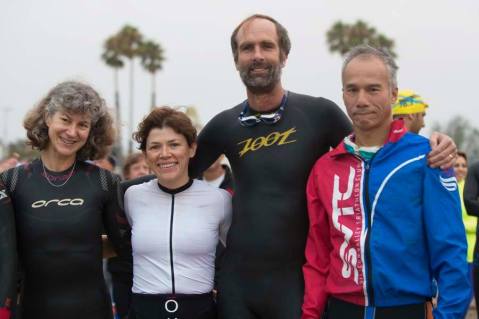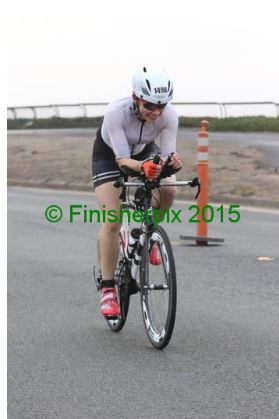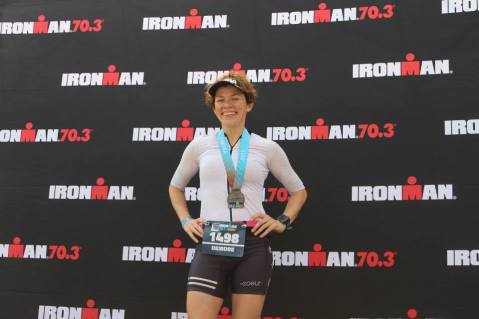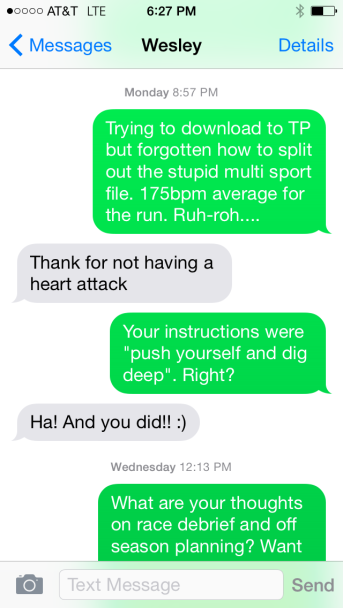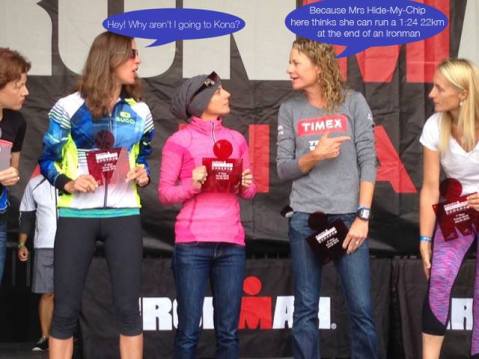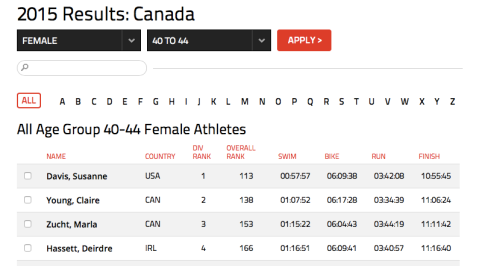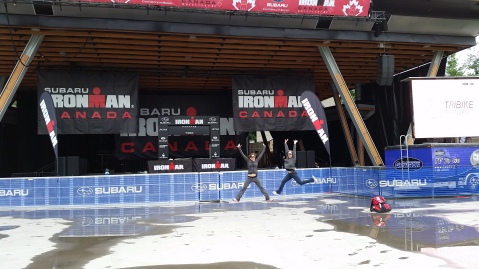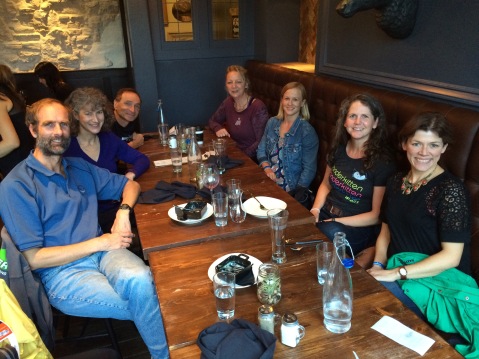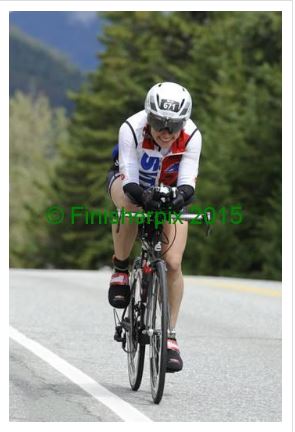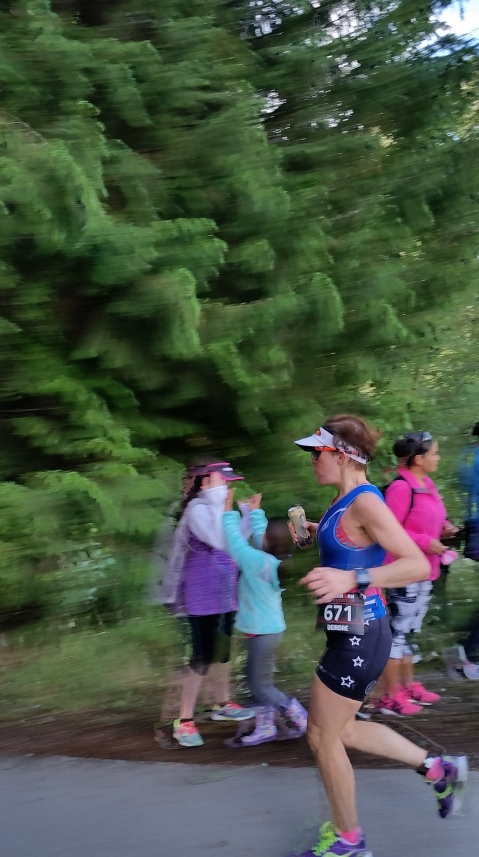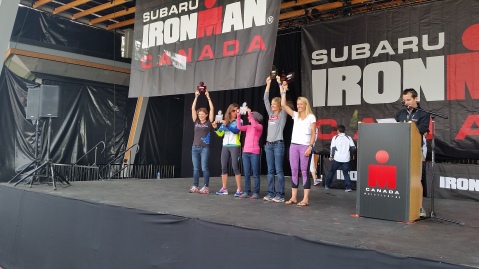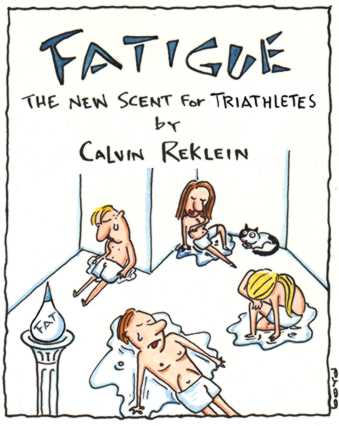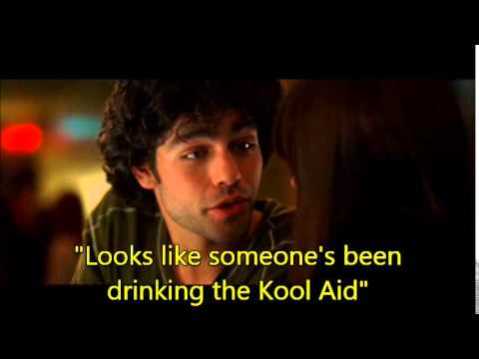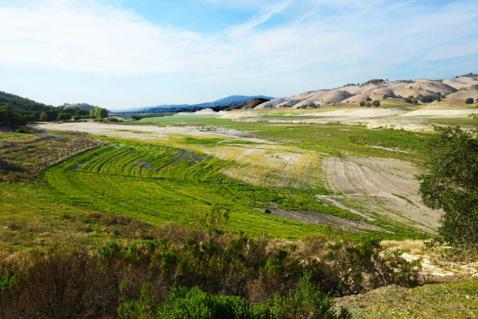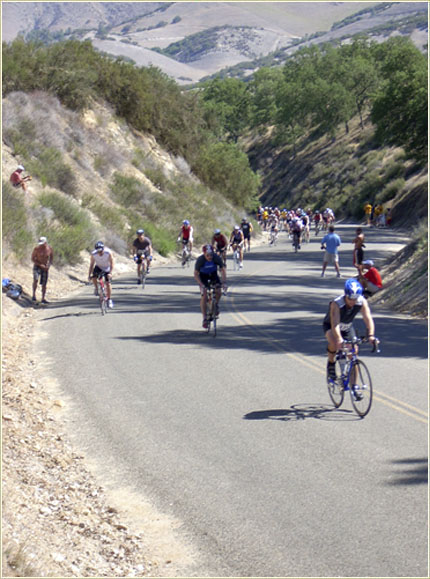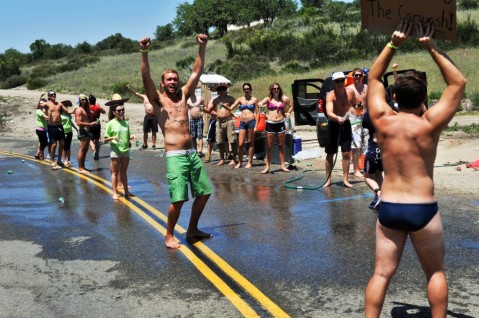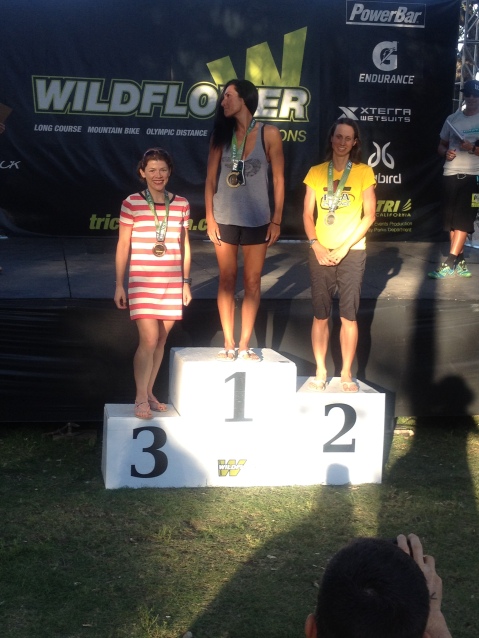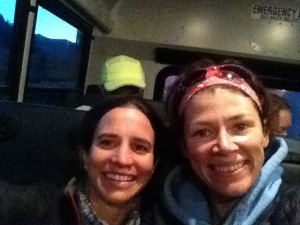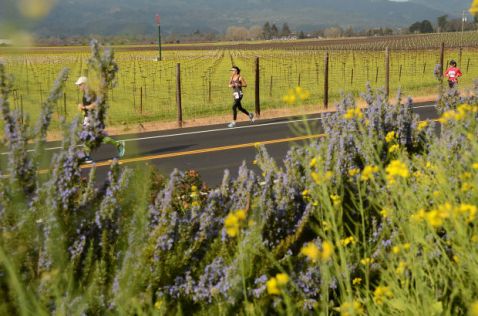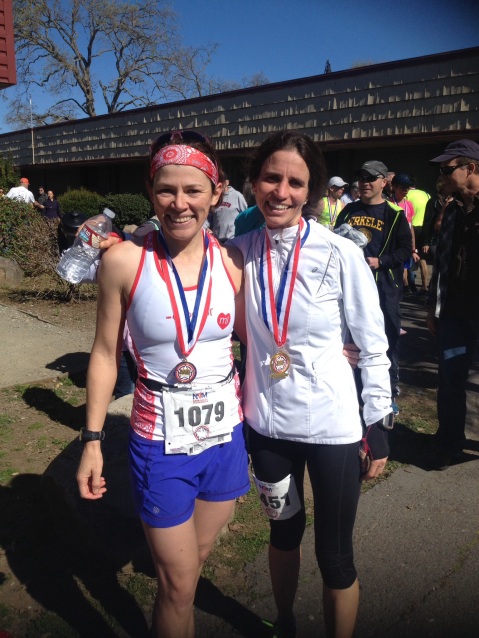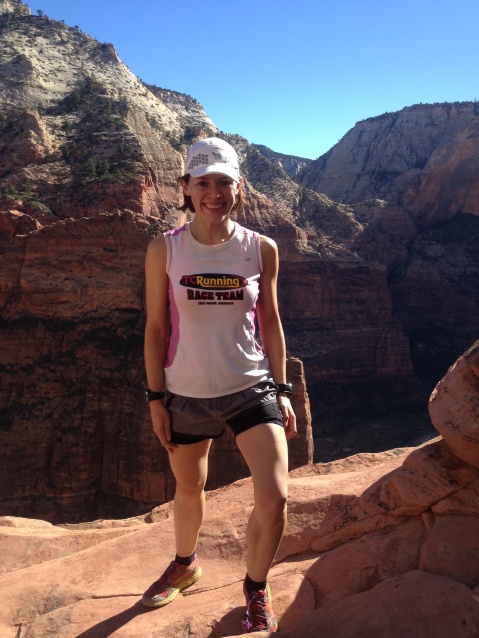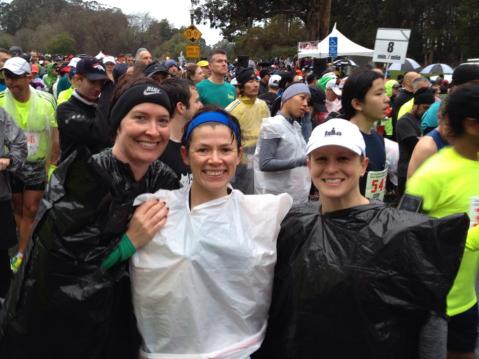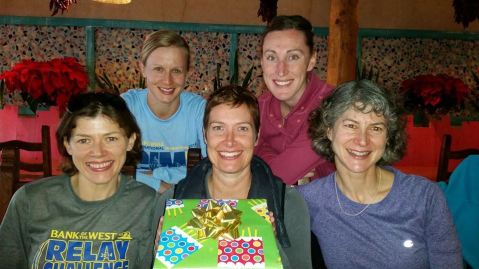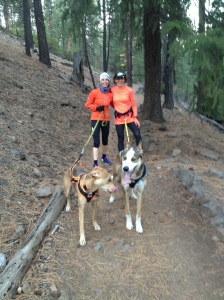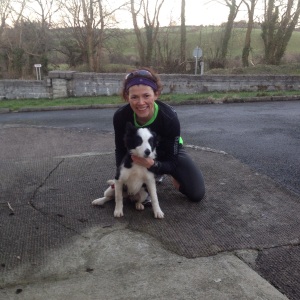A Lemony Snicket Kind of Year
Fate is like a strange, unpopular restaurant, filled with odd waiters who bring you things you never asked for and don’t always like.
Hello, my old friends!
Here we are, on the eve of Santa Cruz Ironman 70.3 2017 and somehow I have lost two years. Well, not lost, per se. A year off triathlon becomes a year off writing, and somehow apathy settles in. 2016 was a year of other adventures (learning to rock climb, learning to mountain bike, conquering the Brazen trail half-marathon series: seriously, who says triathlon is hard? I came closer to dying in each of those races than at any Ironman).
In 2017, I climbed back on the iron horse and started another season of triathlon. I want to tell the stories, and yet somehow have not been able to commit myself to write; to pour out the emotion. Writing, like speechmaking, singing, and cycling uphill, is mostly a case of overcoming inertia; so bear with me. It’s a case of writing something or not at all: Imperfect words are better than none.
It hasn’t been the most unsuccessful season, but it has been one of upsets, incidences, highs and lows; a Lemony Snicket kind of year. 2015 seems (in retrospect) a golden summer of racing, with age-group podiums at my three big ‘A’ races (Wildflower half Ironman; Ironman Canada, where I came tantalizingly close to a Kona slot, and Ironman 70.3 Santa Cruz). This year’s training has been significantly dented by an almost non-stop work travel schedule has which put a lot of stress on my body and made it hard to train consistently at volume. On top of that, I’ve been running on an emotional roller-coaster this year. Call it a post-40 mid-life crisis; with a few of my solid California inner circle of friends (and training partners) moving away and the constant flux of the work travel, I have found myself in somewhat of an existential void, questioning my life decisions. Cap that off with the usual Type-A race anxieties and it’s a miracle I have toed a line this year at all.
I bought the Lesley Paterson book “The Brave Triathlete” which is helpfully subtitled “Calm the F$%k Down and Rise to the Occasion”. The book is well written, and helpful not just for the psychological tips, but for the fact that it helps knowing there are enough crazy athletes out there to warrant writing a book about it. I also just read Devon Yanko’s race report on winning this year’s Leadville 100 mile race, overcoming some psychological demons on the way. Her tip is to treat each adversity point as a Plot Twist. Dropped your nutrition into a ravine? Plot Twist! Just flatted both front and back tires? Plot Twist!
I find the best way to deal with race nerves is to put it all into perspective. In the end, racing is a privileged hobby, and I’m not reliant on it for rent or food; so that bounces me back into focus. At the end, whether I personal-record my race time, or win a prize, or limp over the line in a snot-pasted bundle; life will go on – there will be dinner, and friends to post-mortem with, and Monday morning I will go to work and deal with Real Life. I decided, in the Plot Twist vein, to categorize my season into First World Problems and Real World Problems.
Throwing up in my mouth at the South Bay Duathlon in March on my way to a third place female finish: Plot Twist!
Draft penalty at Ironman 70.3 Santa Rosa: First World Problem [Although I dealt well with the penalty well during the race to push to an overall solid finish time, right on performance; I really took it to heart. It was lack of concentration on my course position and probably the luck of the draw on the overcrowded bike course but I felt like I had somehow failed as an athlete; the draft penalty severely pinched an emotional nerve. At the same time, it was otherwise a solid weekend building on friendships with team-mates].
….then missing an Ironman 70.3 World Championship slot at Chattanooga by TWO SECONDS because of the draft penalty: First World Problem. [I did cry bitterly. Pro tip: don’t drink beer after a 5 hour race and a pizza lunch and expect to be in stoic control of your emotions at the championship roll-down. ].
Losing my car-key in the Grand Canyon on the Rim-to-Rim-to-Rim 42 mile hike on my birthday the week after Santa Rosa 70.3: First World Problem. [It was a rental, nobody died and the whole saga could be resolved to greater or lesser expense with money…but it was a helluva long 10 hours before we retrieved the key. Now THAT’S another story. And what an amazing weekend of adventures with my Minnesota friends, otherwise.]
Having my lovely Cervelo P3 race bike stolen in the Whole Foods parking lot (the same day that my friend Norm crashed badly on our ride): A toss-up between First World and Real World problems – devastating to have my bike stolen but I was lucky enough to have another bike and the resources to replace it.
Riding to a second place Age-Group podium at USA Duathlon Nationals with a brand new replacement/ refitted Cervelo P3 exactly one week after my bike was stolen: Plot Twist! [With many thanks to Rob Mardell at La Dolce Velo in San Jose for fixing me up].
….but missing first place Age-Group podium at USA Duathlon Nationals by FOUR SECONDS because I didn’t realize the girl ahead of my was in my age-group and I (frankly) phoned in the last few miles because I didn’t believe I would be that close to first place: First World Problem (and a life lesson in always, always committing 110%).
My coach (and good friend) crashing badly the same weekend we were at Duathlon Nationals; one day into his two-man Ride Across America race attempt: Real World Problem. Luckily he was safe, and recovered quickly.
Getting my first ever California Highway Patrol bike escort into Healdsburg on the way to winning Barb’s Race (a small women’s charity triathlon in Sonoma) in July: Plot Twist!
….nobody capturing me with in my pink speed suit whizzing behind the CHP: First World Problem
Planning logistics for two long, bone-crunching days in the saddle on my August 200 mile RSVP ride from Seattle to Vancouver: First World Problem
…Spending a day and a half of our planned two days of riding in the ER with Joe, our friend who had a bad bike crash: Real World Problem. [Postnote: He’s healing remarkably well, and now has a bionic plate in his jaw.]
If you read this before Sunday afternoon: send me good juju for my half Ironman in Santa Cruz. I’ve been polishing my Big Kahuna Tiki Guy in preparation. By this time tomorrow, I’ll be eating good Italian food and regaling friends with tales of racing. Good or bad. There will be laundry to do, and bags to pack for work travel. And the off-season will begin; with a task from my coach: to reflect on why I do triathlons and how it brings me happiness. I’ll get back to you on that one but I have a couple of hours tomorrow to think about the answer.
I Want Frosting (IM70.3 Santa Cruz Report)
Our mother wisely never allowed us (six grimy, chocolate and grass stained country kids) to wear a lot of white growing up; a recipe for extra laundry and possibly a short track for being taken into welfare. We inevitably ended up in our boy-cousins’ late 1970’s hand-me-downs, chocolate-brown-and-polyester Fair Isle patterns; robustly defensive against grime. This has stuck with me as a grown-up, a messy eater; I always bear pen marks and coffee stains and salad dressing down the front of my clothes. Somehow I’ve ended up adopting the policy: White is for Special Occasions only and Patterns Don’t Show the Dirt (1). So I’m not sure why I thought adopting a white speed racing bike/ triathlon shirt for this season was a good idea. Coach Wes is a huge proponent of adapting all time-saving technologies, and there are lots of interesting recent studies which show that covering up more skin saves bike watts, making you go faster for the same effort, and the trend of pros racing Kona in shoulder covering speed suits supports that.
http://triathlon.competitor.com/your-aero-edge
I decided that Every Watt is Precious, and hastily invested in a white Castelli triathlon shirt before Ironman Canada (the only women’s cut I could find online). After only one wear at Ironman Canada, it already bore some interesting stains and yellowing armpits. Grubby or no, it needed another few outings to pay its debts to society.
Cut to the inaugural Ironman 70.3 Santa Cruz in September. I had a good chat with Wes before the race. Only six weeks after Ironman Canada, he emphasised that this race was a bonus to the season, where Wildflower and the Ironman had been my big A races. Santa Cruz 70.3 should be the ‘icing on the cake’ – a no-pressure local derby. Of course, local races are the ones that feel most important; a stage to prove your calibre to your friends and competitors. I agreed with him, but flounced a little internally. Fine, it’s the icing on the cake. I WANT FROSTING! I managed to recover pretty well from the Ironman and squeeze in some good (read: excruciating) half-Ironman paced workouts up and down the race route on HWY1 in preparation. The women’s start list for the race looked huge – and fast, as I recognised a few local and out-of-state Ironman stars.
Race day was low key – I was able to sleep at home and get a ride down to the start on race morning with training buddies Mel and Marek. My wave start went off quite late, about 40 minutes after the first wave, so it was an unhurried start to the day. I was surprisingly nervous, weighted a little with self-expectations after Canada, and the thoughts of all those friends cheering on the course. Nerves and all, there was something wonderful and comforting about hanging out on the familiar beach, watching the pinkening sky and surrounded by friends both racing and supporting. The sea is a constant in Ireland, and one of the things I miss about Galway. I feel incredibly lucky to have Santa Cruz, with its honking sea lions and hippy surfer population right on my doorstep and this race epitomized a lot of the good things about my new home in California.
I prefer sea swimming to any other kind, and after pulling off some kind of miraculous swim at Alcatraz a few weeks previously (2) I was quietly confident of blazing my way through, figuring choppy conditions would be better. Alas, it was choppy but my new magical swimming powers had evaporated, and I thrashed and gulped my way around the wharf, the course marker buoys difficult to see in the surf. The course seemed a little long, but clocking in at 39 minutes, and starting on the long 400m run back to transition a sub-5 hour finish was already against the odds.
There is almost no better place in the world to ride a bike than down Highway 1 from Santa Cruz with crashing surf on your left all the way out. It’s mainly fast, flat and rolling with one long, significant hill on the new 70.3 course at Swanton Road about 20 miles in adding about 5 minutes racing time to the old ‘flat’ course. I’d negotiated a pretty generous taper for the race, as I’d felt a little burnt at IM Canada, so my legs felt fresh.
One of the disadvantages of being in one of the late waves is that there is no clear space and I ducked and weaved and jostled all the way out to keep my nose clean out of the draft packs. There was a strong wind towards Santa Cruz, so turning around to head back to town was a joy; clear space on the road for the first time, sea in the air and the wind at my tail. I rolled into transition once again exactly to the minute on my self-predicted time split (3), which makes me wonder if I am placing artificial limits on my cycling based on what I think I can do. The mind is a powerful thing.
At Ironman Canada, I had one of those days where I felt like I could run strongly and at pace forever, so I thought that the Santa Cruz run would be a breeze. Only 13 miles, f’Gawdsake! As soon as I started running, I thought differently. Up the sharp hill out to Cliff Drive and my legs creaked and heartrate soared. My Race Day Prediction (3), now a self-prophesying fulfilment of all kinds of torture, meant I needed to run around 7:30 mile pace to hit my goals and I knew this was going to be ugly. Wes was hanging out to cheer around mile 1, and I could tell from his doubtful face that I didn’t look great. He had clocked me as sixth in my AG and three minutes back from fifth, which initially disappointed me a little – then I realized that this was not a bad position at all for a strong runner with 12 miles to go. One scalp to reach a podium spot. Game on! I had been excited for the beautiful run out Cliff Drive and to Wilder State Park but it suddenly became a war of attrition. Hold this pace. As I inched my way out towards the turnaround, I envied the women in the earlier waves, the race leaders thundering back towards the wharf. I picked off one 40-44 woman. PODIUM! Steady forward progress. Then another. Fourth place. At this point I was close to the turnaround, a mile or so of dirt trail at Wilder and we suddenly popped out onto the cliff edge. My heart soared at the sight of the cliffs and the endless expanse of sea. Rounding the turnaround – they had trucked out the giant Big Kahuna Tiki Guy as the turnaround marker, which gladdened my heart no end – I started to feel a bit better (if only because I had got used to feeling desperate and knowing I only had 10km left).
Following my new discovery at Ironman Canada, I started slamming Red Bull at every aid station, chasing with water to dispel the revolting taste. I had to see the funny side at one aid station where half-asleep volunteers looked bemused as I ran through, hands out, bawling: RED BULL! WATER! (Are my instructions clear enough, confused people?) I nearly choked myself trying to drink a cupful of pretzels that someone handed me instead of water.
I couldn’t wait to return to Aid Station 2, where a gang from Silicon Valley Triathlon Club were handing out drinks. I felt (and looked) grim. My friends cheered me on enthusiastically although our wave was so far back that it was hard for them to tell if I was doing well. With less than a mile to go, I spotted one last woman from my age-group and made a manful bolt for victory, powering past with a bluff of confidence and without looking back. I passed Jerrold from our club at around the same time and later had to explain to him the Irishism of ‘Seeing Jesus’ on the run (4). A downhill cruise to the beach, and then an excruciating, churning quarter of a mile along the sand to the finish, desperately trying to maintain pace, find hard ground and dodge spectators, all the while hoping that I was staying clear of my pursuer. I held her off to finish in third place in my age-group in 5:08. Not a personal best, but a hard-fought race. And to hit a second IM branded race podium in one season was probably beyond my highest expectations for this year.
The race awards were disappointingly low key. I love my Tiki guy (the wooden award from the Big Kahuna) but this year the awards were replaced with $1 bits of red Ironman plastic. The presentation was also a little fragmented as they just called up each individual athlete without any official podium or group shots, but we managed to pull the W40-44 women together to get a group shot, and Kathy even squeezed an ‘Ironman award thingy OVER THE HEAD!” picture (now a running joke from Ironman Canada). Dear Ironman Corporation, please learn how to celebrate your age-group athletes, and spend an extra couple of bucks on proper awards.
When I downloaded my Garmin data, I understood why the run felt so tough. Average heart rate for 13.1 miles: 175 BPM. I texted this titbit to Wes. We had an amusing exchange (reproduced here as it’s funnier):
Tom Davis, a sharp photographer from the club, captured me on the run in the kind of photo that celebrity magazines use to show how bad famous people look without their makeup. Red faced and grim, my face and shirt are shining with layers of sweat, sea salt, snot, drool, energy gels and Red Bull. This was an opera of exquisite suffering.
Afterwards Kathy (who had been volunteering at the station) commented on the photo: “I love the way you race, Deirdre! Snot-dripping, red-faced, full-stride, leave it all out there!” We are primed as women to be pretty, to be photogenic. This was everything but. Is it better to run slowly and have good hair and race pictures? No. I am not the fastest athlete but I have learned how to give 100%, to fulfil my goals, and to lay it out there on race day. Suffering is a skill as important as swim stroke or bike handling, and I handed this in as the last lesson of the season. To borrow the triathlon gear Betty Design’s great slogan: Badass is Beautiful. And don’t forget, people: coloured race kit hides a multitude of sins.
- Saying that, I made it all the way through my 40th birthday party in May in a white J. Crew dress, through copious consumption of red wine and chocolate cake, without any mishaps. Maybe this is the dawn of a new grown-up era.
- Finishing the Alcatraz sea swim in August 3 minutes behind Coach Wes, I am going to paraphrase his analysis of my excellent results as “How the hell did you pull that off?”
- Race Day Prediction (as sent to a few good friends):
| Discipline | Predicted Split | Actual Split | Comment |
| Swim | 36:00 | 39:XX | Optimism based on last year’s smooth fast BK swim. |
| Bike | 2:42 | 2:42 | Woah! Should I start predicting faster bike splits for myself? |
| Run | 1:39 | 1:37 | Run was a little short as they subtracted the T1 400m run to transition.
But: I could not have run a second faster. |
An Unexpected Addendum
I’ll admit I have a bad memory for the unessential. Sometimes I surprise myself by finding some uninteresting, if necessary document I’ve written at work a few months before, of which I have entirely no recollection. For triathlon trivia though, I have the proverbial elephant’s recall. So I was surprised when I got a distracting Friday afternoon message from my Irish Muddy buddy, Ciaran, last week.
Did you get a Kona slot?
Eh, I didn’t get a Kona slot! Didn’t we have this conversation?
I check Messenger and yes, we did have a bouncing conversation about my Ironman Canada race four weeks before. Podium, yes. Fifth place in AG yes. Kona slot – no roll down, no dice. Tough luck but great race.
Jeez, Ciaran, you have an even worse memory than I do!
To end my productivity for the week, he sends me a link to a thread on the discussion forum Slowtwitch, with a long, looooong discussion about an apparent age-group athlete who may be disqualified for cheating at Ironman Canada.
Now, let’s step back a couple of weeks. For brevity, I omitted from my race report that while I initially showed as fifth athlete in my age-group, after an hour I was upgraded to fourth, as the first woman had no chip, and an inconsistency in her marathon time which showed as 3:17. My eagle eyed friends Helen and Pam had been somehow managing (via the dreadfully unwieldy Ironman Live Tracker) to follow my progress through the 40-44 AG ranks, and had already spotted and commented acerbically on the unusually fast marathon time.
I was delighted to move up the podium, so announced my improved result to all and sundry. When I saw at the awards ceremony that there were three Kona slots for my AG and I was fourth, I was disbelieving. It seemed like an almost sure thing. Surely of the top three, one of them would have small children, a teaching job or financial commitments that meant they would let a World Championship place roll down…to me. Of course, when I lined up to receive my award, I’d been demoted to fifth. It seemed the first place girl, who had lost her chip, had been reinstated. I was disappointed both for the lesser position and for the greatly reduced chance of two roll downs occurring. In Europe there are only three podium spots. While I was happy to receive an award, somehow fifth place is just a little too far down to taste the champagne, while fourth feels like I’m hanging in there – just – with the contenders.
As I’ve already recounted, there were no Kona roll downs. I was philosophical about my position – close, but no bananas. Coincidentally the first placed athlete in my AG was standing in front of our vantage point for the awards and both she and her coach vigorously and noisily defended her performance and running capabilities (her coach had put in a protest against her DQ on no chip and her finish time was formally corrected via video footage). It sounded plausible. I shrugged and asked no questions. (1)
Back to Slowtwitch. Now you may not be familiar with Slowtwitch but one of its main attractions is an open discussion forum, where you can chew the fat on everything from gel flavors to the latest DI2 electronic gear shifters. When there’s a good juicy scandal, though, some of the gossip-mongering thread contributors (jokingly but accurately monikered as ‘Twitchhunters’) really get going. To get a flavor of the discussion you’ll need to take a glance at some of the threads (it seems to be requiring a login now after all the heavy discussion traffic last weekend so I can’t post the link here).
At the time of my first reading the thread, Ironman had not officially announced a DQ or updated the race results, so as the Twitchhunters circled the wagons, the poor forum moderator got so stressed about a potential defamation suit for allegations on a named athlete that he locked the thread from comment. I was greedy for information. There were locals in the discussion, and someone close to one of the displaced athletes further down the podium, who had made an official complaint. Everybody seemed to know what was going on! Except me!
To save you the pain of wading through the full discussion, here’s the final potted summary from more than one source. I’m not even going to mention the DQ athlete’s name – you can see it on the Evernote analysis below. She has posted some other impressive race results (including ITU Long Course world AG champion in 2014) which are now heavily in question.
- The athlete ‘lost her chip’ in T2, allegedly because she changed her clothes. As someone pointed out, it seems unlikely that someone trying to KQ would do a full clothes change including shorts and compression socks. One of the big sticking points on the Slowtwitch forum is that the DQ athlete had “lost” her chip not once but TWICE, also ‘losing’ it in 2013 on the same course at Ironman Canada.
- Proof of her finish time was provided via the video camera on the finish line, but of course she had no formal mid-run splits since she had no chip.
- She never passed the second placed 40-44 athlete on the run course (she was aware she was leading off the bike).
- Due to some excellent detective work by an interested party (I think the husband of a podium athlete in our AG), an assessment of the athlete times passing specific photographers out on the run course was done. They were able to locate the photographers at specific distances on the run course, and link our DQ friend to a specific time of day based on the athletes around her also passing the photographer at that time. Check out the summary of this on Evernote:
Evernote analysis of the DQ athlete’s run splits from photo evidence
To summarize: her times show a staggering (and men’s IM world-record-breaking) time of 1:22 for the first 13 miles of her IM marathon. This of course leaves her with an interestingly pedestrian 2:20 for the second 13 miles – around 11 min/ mile pace to finish at her official marathon time of 3:31.
The Twitchhunters are fantastically probing gossips, and everything from her coach’s knowledge or otherwise of her actions to the size of her thighs are called into question. I’ve never considered cheating, but if I had, the stone throwing of the Slowtwitch forum and the public contemplation of my cellulite (alone) would make me think twice. It’s hard to understand the motivation of an apparently serial cheater, particularly at our level – let’s face it, a comfortably long way below the professionals, and where the grand prize is an M-Dot shaped piece of plastic.
Oh, and since we’re mocking the podium shots, here’s one that actually came from my phone:
It would have been lovely to end this post with the call from Ironman offering me the roll down slot, but before the news of my place upgrade could even sink in, I noted from the forum that someone local to Squamish, BC confirmed that the originally fourth placed athlete had already been offered the third Kona spot, before the official results were even corrected online. Ha.
I stomped off to Sports Basement that evening to look ostensibly at renting a wetsuit for my Alacatraz swim the next day. I was flustered and crestfallen all over again. I kept stabbing at the Slowtwitch link, hoping the moderator would re-open it for comment. While I’d settled that I was fifth and ten minutes off a Kona slot, now I was fourth and FIVE minutes off a KQ. It was like I’d lost something I didn’t know I had. The third time the poor Sports Basement rep. mentioned ‘your Team in Training discount’, I snapped at him.
I’m not in Team in Training! (2)
Five minutes off third place which also included three fumbling stops to reattach my repair kit (3) (worth 2-3 minutes) and a couple of portapottie stops. I couldn’t have cut the portapottie stops (sometimes a girl’s gotta do etc.) but eliminating the repair kit stops and a little more surge on my somewhat conservative bike split would have had me on par with third place.
Woulda, shoulda, coulda. I could have done it, and that is bittersweet. So close….I’m wary of falling into the ‘just one more go’ trap that so many aspiring KQ athletes fall into, racing Ironman year after year for that tantalizing golden ticket. Next year? I’ll take some philosophical fall off-season time first and we’ll see.
Some happy endings: while I don’t get to change the Ironman podium shots, IM Canada did formally DQ the athlete that evening so I’m officially fourth.
Triathlete Magazine Canada Official Statement
I e-mailed the Ironman Canada race director to upgrade my award to fourth place and – full credit! – they are ordering me a new one which I should get in the post shortly. If I’m going to race fair and square for a piece of red plastic (4) I’m going to make bloody sure it’s the right one.
- Technically, no-chip (aside at all from any hint of impropriety) is a disqualification offence as you don’t have proof of your official time.
- While I appreciate and respect the introduction to triathlon and solid training foundation that Team in Training and their ilk provide new athletes, they are not exactly known for cleaning up world championship slots.
- My saddle is so far forward because of my shorty legs that none of the regular repair kit bags fit on the rails. I jerry rigged it for the race but it didn’t work well.
- And spend thousands of dollars in race and travel fees for the privilege.
The Mirinda Project (Ironman Canada Race Report)
T minus 18 hours, and I am sitting enveloped in a comforting bearhug at IM HQ in the Whistler Olympic Plaza. I can’t help thinking wryly of Temple Grandin, the fascinating autistic woman who developed a hug machine for calming cattle being sent to slaughter(1). How apt. Despite my best intentions (third Ironman, totally calm, blah blah blah) – the animal brain has taken over, and mild panic has set in. The hug machine is totally accidental. I’d been complaining about my knotty, tight back, and after bike check in I dragged my race buddy Suzanne over to the ART(2) tent for a free 15 minute consultation. After the (handsome, 30-something) therapist made some impressed noises about the state of my knots, I found myself tucked into his arms as he manipulated my ribs back into place. Of all the stuff Ironman charge exorbitantly for, this is free? How did they miss this outrageously obvious source of revenue in their business plan?
Ironman Canada takes place at Whistler, BC – said to be one of the most beautiful Ironman courses. It’s also pretty hilly by Ironman standards, with 6,200 feet of climbing on the bike. Suzanne(3) and I had long ago signed up for the race but delightfully our training buddies Mel and Marek, who are Canadian citizens and who moved to the Bay area from Vancouver two years ago, offered up their cabin in Whistler for the race. Serendipity! Then our triathlete friend Kathy (who takes Iron Sherpa-ing(4) very seriously) joined us for the weekend, along with Suzanne’s boyfriend, Brian. In terms of athlete-to-sherpa ratio, this was pretty deluxe (particularly compared to my first Ironman, where I tearily dragged my post-race vomit-spattered self, my bicycle and my three filthy gear bags the two rainy miles back to my hotel on foot).
Aside from the spectacular chocolate-box scenery (snow capped mountains, green lakes etc.), Whistler, as a ski resort, is ideal for an Ironman race. Six hours to kill while your athlete is risking near-death hypothermia out on Pemberton? Plenty of choices for coffee, brunch and maybe a cheeky beer. No hurry, darling.
I had some clear personal goals in place for the race but I was unsure that my fastest race day would get me to what I thought was realistic (a lower podium spot), let alone a coveted Kona World Championships slot (which I didn’t think was realistic based on IM Sweden where there was only one Kona slot for each female age group). The night before, Kathy made us complete some split estimates for the race so that the gang could track us easily on the course. I gave her my swim estimate (1:15 to 1:20), bike estimate (6:00 to 6:15) and then she asked me about the run. There was no window; I was going to run 3:40. She gave me a Look, and wrote it down.(5)
One of the risks of a mountains-based race (see also: two years of Lake Tahoe IM weather disasters) is that it can be very, very hot, or very, very cold. Four weeks out from the race, it was topping 100F (38C) on the long nasty 10 mile Pemberton climb which comes 90 miles into the bike leg of the race. As race day approached though, the temperature forecast kept plummeting and the likelihood of rain spiraled to what was going to be a Long Wet Cold Dark Teatime of the Soul.
The swim was possibly the warmest part of the day (a pleasant 70F), and uneventful apart from the ritual tiny pre-start panic, a salty tear shed into each goggle at the heaving behemoth of bodies about to potentially smack me to the bottom of this Big Green Lake. I beat my previous swim PR by 7 minutes at 1:16, thanks in no small part to my coach, the ever-patient Wes, who spent a lot of time coaxing me mentally into being a better swimmer, technique aside.
Properly epic races are afterwards tagged in my head: (Hottest; Hilliest etc.) Ironman Canada will be filed under Maybe the Coldest Race I Ever Did.(6) Now, technically I have done colder training days in Ireland on a bicycle (more than once weeping and taking my hands out of my ski gloves to lick my icy fingers once the Connemara Coast), but for race misery, this was up there. I had thought a lot about my gear on the bike, and went with arm warmers, toe warmers and a cycling vest over my very light new aero racing jersey; a hairsbreadth balance between staying warm enough, not getting too warm (and having to discard very expensive gear on the course), and not spending valuable minutes in transition doing a full change. It was raining heavily straight out of the gate, and an hour in, I was freezing and struggling to concentrate. I sniveled my way along the slippery, waterlogged course for another hour or so, fantasizing about dropping out, and quietly wailing “I’m sooooooo cold!” over and over.
My hands stopped working, and I couldn’t manipulate my food out of my storage bag so I started to grab the on-course race nutrition (Honey Stinger waffles), which luckily worked well. A Macgyver moment ensued as I stopped to rip off my ailing bike repair kit which had come loose, and ended up opening the velcro with my teeth as my frozen hands were useless.
I think (and talk) a lot about mental toughness but cold is a particular Achilles heel for me (I don’t stay warm well and I don’t do well in cold races, except maybe for running, where your body temperature looks after itself). Hence a long internal battle began. Now, I fantasize about dropping during every race, usually in the first third of the bike leg when future suffering is laid out on the roadside like a long smorgasbord all the way to the finish. The trick is to postpone the dropping as long as possible until the feeling goes away (well, or until I tip over from hypothermia/ heatstroke, whichever comes first). I had a long internal dialogue about the pros and cons of dropping out. I had packed my new Ironman Canada hoodie into my dry clothes bag at the finish, and the thought of Suzanne and I celebrating our finish, and the stupid hoodie, which somehow symbolized everything that had gone into the preparation for the day and finish, kept me on the bike until I warmed up.
Around 70-80km into the bike course, it stopped raining. At this point (including a couple of brief stops for my errant saddle bag); I was convinced I was having the Worst Bike Split Ever, until I met Brynje(7), a friend and amazing athlete from Colorado who I know through Coach Muddy on the course. She’s a stronger biker than me, so meeting her made me realize that I wasn’t the only one struggling out there and gave me a jolt of focus. There was a long fast flat stretch out and back from Pemberton to the turnaround and back, which cheered me up a lot as I started gaining time and picking up places. I was mentally prepared for the big 10 mile Pemberton climb, but my legs felt tired and strained, and I was a bit worried about how they would feel on the run.
I had one plan for the run: to run like Rinny (Mirinda Carfrae), the pocket-sized Aussie Ironman double World Champion, who swims passably, bikes well, and runs like a monster through the ranks onto the podium. I had no idea how I was doing position wise (I figured I might be running my way into tenth place), so the plan was to run fast, efficient even splits and mow as many women down as possible. Once running, I felt terrific. I love to run off the bike, and the Whistler course was a treat, two loops all run on cycle paths and trails, circling one lake, and with a long out-and-back along Green Lake, which is picture-postcard perfect. I tick, tick, tocked off each kilometer, with the vision of even splits dancing like sugar plums in my head. My ‘Special Needs’ bag held a sugary iced espresso drink at km 25, but by then IronStomach had set in, and Kathy snapped a picture of me running with intense focus, looking suspiciously at the contents of my Starbucks drink. I had a moment of fabulous clarity then, and started drinking Red Bull (which I loathe, but which is full of sugar and glorious, glorious caffeine which I tried to inhale at each aid station without tasting).
I didn’t really start to suffer until the last 10km, during which I passed a last woman from my age group, so I was running scared (if only I knew! That scalp bumped me onto the podium). My Vancouver buddy, coach Andrew, rolled up alongside me on his mountain bike at km 40 and started cheerfully shouting encouragement. I was deep in a cave of just-hold-on suffering and bellowed something like “I can’t talk now! Jaysis! Go away!” Held on, held on and crossed the line at 11:16 (with an official marathon time of 3:40) (8).
As soon as I had staggered away from the finish line, I made Kathy look up my place. She announced I was fifth in my age-group, and at first I was bitterly disappointed until she pointed out that there are five podium spots in North American races. My first Ironman podium, and I was going to celebrate every minute of it. Ironically, having moved up an age group, the 35-39 AG was unusually slow this year for some reason, and I would have placed first in it with my 40-44 5th place time.
I was ready for the podium shot. It was an official bucket list item: win a podium spot at Ironman, get an M-Dot shaped award thingy, HOLD THE M-DOT OVER MY HEAD. Somehow one of the girls on the podium had not got this brief, and failed to grab the vision. So there are lots of shots of me enthusiastically brandishing my (cheap, plastic) M-DOT thingy OVER MY HEAD while the official photographer patiently explains to the bemused 4th Place 40-44 over and again where to hold her award.
There were three Kona World Championship slots for my age-group (the biggest women’s AG with 122 finishers). Just like my fourth place finish at IM Sweden – near and yet so far. I was somewhat philosophical about a Kona slot: I had raced the best I could; what would be would be. Breath held – at 5th, with three slots, I had more hope of a roll-down than in Sweden, but in the end, the slot awards lacked drama; the first three girls grabbed their leis and places before I exhaled.
First thought: Crushing disappointment.
Second thought: Well, just saved myself $3,000 and the pain of training for a second (very hot) Ironman this year.
Third thought: Now I am glad I bought the expensive Merrell IM Canada jacket; I’m winning by $2850.
Next up: IM 70.3 Santa Cruz in September, and I’m finally confident of a clear run at < 4:59:59. The more races I do, the more I believe I have to believe (and I am not sure I did this year). Next stab at IM and a lei (on the now established two-year IM cycle) will be 2017. I’d better start believing.
Footnotes:
(1) Okay, I’m obsessed with public radio/ NPR but check out this interview of Temple Grandin by Terry Gross on Fresh Air:
NPR Temple Grandin Interview on Fresh Air
(2) Active Release Therapy. It’s an awesome physio Thing. Check it out.
(3) You can also read Suzanne’s (somewhat more descriptive) race report here:
Suzanne’s ‘Fabulous Campaign’ Blog – IM Canada Report
(4) Being a Sherpa for a race is not a term used in Europe for some reason, but it means traveling to the race, schlepping around other people’s stuff, cheering enthusiastically and generally satisfying all of the outrageous demands of the highly-strung, overstimulated athlete you are accompanying.
(5) You can ask Kathy, she has the piece of paper.
(6) I’ll say it once and again, Ironman racing is a wimp’s sport compared to trail running – I’ve just read my friend Alicia’s entertaining report of her attempt to break a 5-day unsupported trail record in Vermont, and am still reeling from Valeria’s nail biting 47-hour Hardrock race finish. Except maybe for Norseman 140.6 which sounds legitimately miserable, and which I would probably not survive cold-wise. Respect to Sonja!
Sonja’s CoeurSports interview on her Norseman finish
(7) Brynje’s day was made pretty challenging by her carbon rims which are pretty useless in wet weather, making all the descents absolutely hair raising.
(8) I originally had a somewhat ambitious plan to double up a Boston Qualifying marathon with Ironman (it’s technically allowable if the organizers will certify the course) – the IM Canada organizers did not have the marathon certified to road standards so I wouldn’t be able to use it… but I did BQ!
Drinking the Kool Aid…
Sometimes I wake up in the morning (or mid-workout) and ask myself, a la Talking Heads: “How Did I Get Here?” It’s three weeks until Ironman Canada, and I’m tired. Physically tired, yes, that goes with the territory, but also mentally. My house is grubby (and I have no cleaning products to clean it with. I spend a bemused fifteen minutes trying to buy laundry soap en Espanol in nearby Felipe’s Mexican food store because, you know – it takes too long to drive the single mile to Safeway). I do not have time to volunteer at the Stanford kids’ triathlon, because five hours of volunteering on a Sunday morning is not compatible with a twenty mile run. My life is a round of work and gear bags and careful packing of endless Tupperware’ed meals and snacks to be consumed before/ during/ after workouts which seamlessly top and tail the working day.
Racing Ironman triathlons is a way of creating First World Problems to keep people with no proper troubles of their own out of mischief. The concentration of stereotypical Type A overachievers that seem to make up the bulk of the sport is multiplied here in Silicon Valley, which has its own special gravitational field for the over-accomplished. Of course in triathlon circles, the Ironman race distance* is somehow considered, in the ‘more is more’ world of endurance sports, to be the pinnacle of the sport; longer being a greater achievement. To finish an Ironman is certainly a great achievement, but after that, longer is just longer. It can be harder to race short and really, really fast than to slog around a just-under-the-cutoff 17 hour Ironman. Of course, being a Diesel Engine, Ironman racing (and half-Ironman racing) play to my strengths – I don’t have to go very fast, just perform the underrated party trick of sustaining 70-80% of my top speed for a very long time.
Ironman training is a funny thing – a mix of highs and lows, the onerous and the triumphant. Coach Wes keeps reminding me: “Enjoy the journey”. Because if you’re not having fun training, the Ironman journey is an exquisitely long and painful slog to a single day of racing. I still love to train – I am unsure whether racing is the stick and training the carrot (or vice versa). I wouldn’t have survived 10 years in the sport if I didn’t. And yet there are big disadvantages to it. Ironman training can leave the body on a knife edge of fatigue, and I’ve wept more than once in the last few months, brought to enraged crankiness and sleep-deprived desperation, usually by some tiny trigger like a flat tire. If I were to advise one key to successful and enjoyable Ironman training (if that’s not an oxymoron) – it would be: get enough sleep. My career and training quality (and my relationships with my long suffering friends and training buddies) depend crucially on it, being someone who is not good at operating under sleep deprivation. It’s really hard to manage so that I have the mental energy for work, and sometimes more than one training session a day (and l don’t even have kids – like I said, First World Problems), so I’m glad to be training on the Less-is-More principle. If I get fired, I’m not sure how I’d pay for that ticket to Kona anyway.
I am thankful that, while my swim training has been much more focused on technique and improving my speed this year, that my workouts include nothing much over 3,000yd (way short of the kind of obscene pool mileage that I know some Ironman trainee swimmers put in). Although I’m still heartsore at the thought of every swim workout, much of which involve swimming 50’s or 100’s at bile-inducing intensity, at least I am not dangling my feet in the water mournfully while contemplating the 75 minute Existential Void that is 6 x 500m (or 3 x 1000m or 1 x 3000m) Steady, of which workouts made up the bulk of my last two Ironman journeys. Is this enough swimming to be Ironman ready? I figure my swim time cannot disimprove from the Existential Void years. Watch this space.
I love and anticipate the big weekend IM rides, with mountain passes and redwoods and coastline (and century ride aid stations with pie). This year, I’ve been doing much of my riding at prescribed power intensity to mimic half-Ironman to Ironman race pace. This is a double edged sword – it can be fun to go out and hammer the pedals (in a controlled fashion) for speed; shooting up and down Highway 1 or Portola Road; at other times, I long for the only vaguely pace-controlled meanderings of previous years. I’ve been lucky enough to have company for a lot of the epic interval rides, but they are still pretty anti-social: aero position, 10 meters apart, pedal furiously: GO! See you in 30 minutes for the next easy spin break…
Which brings me to this year: how do I feel about the big day coming up? Well, there are many ways to skin a cat, and as many to train for long-course triathlon (lots of long, slow low-intensity training; low mileage high intensity interval training; low technology, high technology). I’ve tried a few different approaches (all erring on the side of low mileage though). My coach’s approach this year has been a bit different than in the past – very specific to Ironman (no showboating at the Thursday triathlon club ride, no track running, and a lot of pace-specific long rides), designed to bring me to peak fitness just for the big day and not before. I think it’s important mentally to believe in the program you are training to, so I am closely following the plan and drinking the Kool Aid.
Last week I did my final big workout. Minor meltdown before: 3:45 bike ride at half-Ironman to Ironman pace, followed by an 18 mile Ironman-pace run? (Bearing in mind that I’d had three big weekends of peak workouts already, as coach moved this one to facilitate my travel to Ireland the following week). After a bit of grumping and hedging about the bike pace, I realized that it was really almost the same peak workout I had done for Sweden (and Frankfurt) under Coach Rich: the Metric Ironman (112km bike ride and 26km run at race pace). This kind of workout holds an enormous mental challenge; as luck would have it I had to do it all by myself. It’s a long day, but I found myself calm, not over-fatigued and falling easily into ‘flow’ mode on the bike, working on holding power, and filtering the thoughts from the week. Off the bike, fueled with Bluebottle New Orleans style Iced Coffee** I knocked out 16 miles at Ironman run pace. I now declare myself Fully Cooked and Ready.
The next question: how do I think I will do? Well, mechanical snafus and nutritional mishaps aside – who knows? I’ve been asked more than once if I think I’ll qualify for Kona. Right now based on studying the past age-group competition results at Whistler, and my own race results, I am simply not fast enough. There’s another quantum leap I need to make on the bike to ride sub six hours on the kind of hills that Whistler brings. (Not to mention the crucial 10 to 15 minute swim handicap I am still carrying). That’s not to say I won’t try my dangdest. I’ll still ride like a monster (the only way to ride. Good Monster!) and I’ll still run my way up the ranking; the question will just be – how far? I don’t know what next year will bring. I need time and energy in my life for other things aside from training – for singing, for dating and socializing, for cooking meals that are not Trader Joe’s pre-grilled chicken; for writing***; things that require time and energy which Ironman training currently consumes. Chasing the Kona dream (unless I am very lucky) would take years, to make the kind of improvements I need (and I hope are in there somewhere); I’m not sure if I want to eat up some of the best years of my life with such time-consuming training. I am sure I’ll be racing next year, just maybe shorter. Ask me again in August when I see you on the other side.
*Whaddya mean, how far is an Ironman triathlon? Of course you know! 2.4 mile swim/ 112 mile bike ride/ 26 mile run OR 3.8km swim/ 180km bike ride/ 42km run. In that sequence, since you’re asking.
** You can buy the pre-cartoned Blue Bottle coffee in Whole Foods; there’s quite a bit of sugar in it so the caffeine/ sugar/ protein combo replaces a gel perfectly (and tastes a lot better). This stuff is delicious dynamite; I may be packing some for my special needs bag at IM. Caveat emptor, though, I do have an iron gut for coffee products.
***I only seem to have energy and time to write at the moment when trapped on a plane. Hello from over the Atlantic.
This is Forty: Wildflower Race Report
There is a brief unmeasurable moment between question and response, when the mind floods with a thousand thoughts before answering.
“Age?”
I was queued up for body marking at Wildflower right before getting on the shuttle bus to the swim start. I don’t know why they bother with race body marking any more, except that having your age numbered on the left calf is a useful aide to hunting down the opposition on course.
[“Technically, I’m not forty yet…but I will be in about three weeks…so I’m actually still thirty nine…but racing in a new age group; 40-44. Happy birthday to me. Here we go.”]
“Forty”
The Wildflower Half Ironman is one of the Big Daddy races in California. I’d heard of it first years before in 2006 (still a rookie triathlete and barely able to swim), when Ray Glynn, our Galway club chairman and his then-fiancee Siobhan, stopped off in California to take the race in en route to their Hawaiian wedding, a trip which seemed unfeasibly glamorous and exotic to me at the time.* Now over thirty years old, the race festival billed as the ‘Woodstock of Triathlon’ brought in over 30,000 athletes and supporters camping out at Lake San Antonio for race weekend (including an Olympic distance race and mountain bike sprint) in its heyday. It’s a blindingly tough course, with 4000ft of climbing on the bike, including the dreaded four mile ‘Nasty Grade’ climb in relentless beating sunshine, and a run mostly on exposed trail, with some steep hills that most people walk up. Despite (or maybe because of) this, the race competition is always very high, with a stacked field of age-groupers outside the pro race.
In recent years, the area has been blighted badly by California’s severe drought, so that Lake San Antonio is now a dry bed. To preserve the original race and transition layout, the race organizers have cobbled together a modified layout, including swimming in a lake two miles away within the park and a two mile run on trail to the original bike transition. The bike course remains unchanged, and the run course is modified to 11 miles to allow for the two mile run from the swim. Numbers of racers have dropped off in the last year or two, as the difficulty of the race and the modified course deters the slower age-groupers and the purists. I was determined to tick this race off the California bucket list: modifications, heat, mud puddle swim and all.** Fittingly, along with my Big Birthday, 2015 is the ten year anniversary of my first triathlon, the Galway Triathlon (Olympic/ International distance, then held on the grounds of University College Galway in Dangan). Ten years pass in a heartbeat and a lifetime, and here I am, a faster, bolder, tougher me. [With brand new one-week-old HED race wheels that didn’t make it to the race because I couldn’t find the exotic combination of 650cc tubes with 8cm valves in time. It’s taken me this long to buy race wheels because I always felt that I couldn’t justify the enormous outlay against the somewhat small time gains, but race after race I pass slower athletes than me with race wheels, so I finally decided that Yes, I am Entitled to Be a Contender, and I bought a goddarn set of wheels for my birthday.]
Down in a slightly remote section of Central California near Paso Robles, the race course is isolated enough that if you don’t camp, you’re faced with a one hour commute into the park on race morning. Camping is really part of the higgledy-piggledy fun of Wildflower, so I elected to travel down and camp with my training buddies and fellow racers from Silicon Valley Triathlon Club, Mel and Marek. SVTC had their own designated campsite and Diana had gone down ahead and kindly set up our tents, so arriving at the very last minute on Friday evening for a Saturday morning race, all we had to do was pick up our packets, eat and get our race gear ready.
I had a luxurious, if somewhat fitful sleep (camping solo in a three man tent with a double air mattress is not exactly a hardship) before rolling out of bed for race day.
While we shivered our way to the start, by the time the swim waves started just before 8am the temperature was pleasantly warm (a precursor to the high summer temperatures of the Central Valley). Spectating here the previous year, the temperature was relentless, around 100F (35C) so I was hoping for a more gentle day today (and the forecast predicted high 70’s or somewhere in mid 20’s C). I’ve been working hard on my swimming with lots of guidance from my new coach and training buddy, Wes, but realistically it’s only been a couple of months since I started working with him, and it’s probably at least a year’s project before I start reaping any significant time benefits. I had the usual desultory swim (including some mandatory confused/ bad sighting decisions), and hopped out of the water a bit crestfallen with my time.
The two mile trail run to bike transition (starting up a long vertiginous concrete boat ramp) cheered me up. Already time to start playing catch up. I had guesstimated my finish time around 5:30 to 5:45 which would put me in the vicinity of an age-group podium. The numbers of women in my wave (40-49) certainly seemed diminished this year, but I am always a bit nervous about putting too much weight on an AG prize as it simply depends on who else shows up on the day.
The bike leg starts with a steep climb out of the park, followed by a long fast flat section all the way to mile 40, where ‘Nasty Grade’ – and the race – really begins. I have started using a power meter*** in the last few months (yup, it’s been an expensive year so far), and while some athletes and coaches are wary of over-relying on technology, it has been an eye-opening learning curve to figure out racing with power. I’ve guesstimated half IM race pace on feel up to now (and I’ve completed about 9 half IM’s) but the power meter is a great tool where most age-groupers fail: mashing far too hard on the hills and cruising far too easily on the descents. I’d done a threshold test to set my Half IM pace on Canada Road a month or two previously, and I suspected that the pace (at 80% of threshold wattage) would feel too easy. I suspected wrong. I worked like a dog, more so on the descents where my handling skills are weak and I tend to lose time by cruising. The temperature ramped quickly, so that by the time I got to Nasty Grade, the sun beat relentlessly on the windless hill, as hapless athletes ground their way up to the top (there were the inevitable few walkers). I was making good inroads into my swim deficit, passing women consistently along the race course and hoping I was one step closer to the podium. After Nasty Grade is another long climb back into the park to transition. I’d hoped to inch close to 3 hours on the bike course; I was pleased to be just over at 3:04 with all the hills as I rolled into transition (would the HED’s have taken me under 3 hours? I don’t know).
I started running with whiny-child-thoughts running through my head. “Ah doan wanna goooo!” It took a while to settle down into a rhythm. The pace is highly variable due to the terrain, so one mile may be 8 minute pace, and the next 10, while running hard. The temperature was in the 80’s F (around 27-28C), hot enough but a temperature that I can survive pretty well. There were good aid stations every mile, manned by students from the University of San Luis Obispo. Part of Wildflower history is that the whole race is reliant on the students volunteering for the whole weekend, for everything from race check in to chip removal. They are great volunteers, partying hard, cheering loud and providing humor and noise at the remote sections of the course where there are no spectators (there’s also purportedly a naked aid station but no sign of that this year).
I ran on feel and heart rate, running a little scared to ensure no women passed, and trying to pick off one athlete (male or female) at a time. I didn’t see a single woman from my age-group on the whole run which started to let me breathe easier. The run is made easier by the fact that with the two transition miles under the belt, the first mile marker is ‘Mile 3’, which provides a cheering mind trick the whole way. There were a couple of very hot, grim miles in the middle, with steep ascents on trail, which I hiked up. After those, I started to pick up pace and enjoy myself. The last mile is gloriously downhill on pavement, and I pounded my way to the finishers’ chute, which, lined with country flags, is one of the best, most atmospheric finishing areas I’ve seen at a race. I whooped down the chute (a bit disappointed with the clearly thinner ranks of supporters this year), pipping in at 5:39, close to my finish time guesstimate. After waiting for Marek to finish, I went to check the results, thrilling with anticipation. I placed third in my age group and 16th overall in the women’s race, in a fast, somewhat top-heavy field.
The post-race party is what makes Wildflower special. The festival area in front of transition has music, food trucks and beer as well as the usual sports stalls. I burped my way through a huge burrito and a beer before scrubbing up for the awards ceremony; retrieving Marek from the medical tent on the way for his post IV liquid dinner of Sierra Nevada.
Being somewhat of a top-of-mid packer, often just out of reach of the age-group awards, I am never blasé about a podium place. I am always excited to accept an award (be it pint glass or trophy or boxes of Clif Bars), and placing at Wildflower is particularly special. I showered and changed and patched up my red post-race complexion as best I could. Ready for my close-up, Mr. De Mille…
If I have a specific talent in triathlon, it’s for suffering just a little harder than the next person, and I was thrilled with my podium slot at a tough race like Wildflower, which was a fitting and special way to celebrate both my 40th birthday and 10 years of triathlon. How much have I learned and changed in ten years? If anything – I have learned over and over again: how to persevere, how to face the most daunting challenges (and usually that rock bottom days are in training, not racing), and how to break each big race or training day down into tiny manageable chunks. I like to summarize triathlon as a life lesson in the great distance runner Mo Farah’s motto (and probably mumble this at least once a day, at work as well as during training): “One mo’ mile.”
This is forty and the view looks good from here.
*I unearthed Ray’s original race report from the Galway Triathlon Club archives last month but -alas! – it’s been lost forever with the brand new website update just a week ago…
**Water conditions seemed much better (and a bit higher) this year in Harris Lake but last year, due to the low water conditions and churn up at the edge of the lake, racers climbed out of the water covered in beards of silt and sludge.
***I bought a Garmin Vector single pedal power meter, for those of you who are interested. It only measures left-leg power but is half the price of the dual pedal power meter set. Here’s DC Rainmaker’s summary:
http://www.dcrainmaker.com/2014/08/announces-cycling-dynamics.html
Don’t Try This At Home – Napa Valley Marathon Report
After the royal exercise in self-flagellation that was the Boston Marathon last year, I had no intention of doing another marathon this spring, especially as it’s bad timing for building up a good triathlon base for a summer Ironman. When the Russians announced they were coming to town, though (okay, not just the Russians, they also brought the rest of my Minnesota running buddies, Kami, Vale and Eric), I couldn’t resist. A weekend in Napa with some really good food and wine after the race, a nice resort hotel and a low-hassle fast course that I could use to knock out a Boston Qualifier for 2016….it would be a winner.
The Russians are collectively the Igors (yes, Igor and Igor), and their smart, lovely wives Yelena and Tatiana. They’ve all lived in the US for over 20 years, but retain robust Russian accents. Igor E has a tendency towards pithy non-sequiturs: [“What is your experience of winter survival racing?” “I am from Minsk.”] As it happens, Igor E was the only one of the Russians running the marathon; while he’s an experienced ultra runner and Ironman, his success as CEO of his own software company has diminished his opportunity to train, so he went into the race on less than a skeleton training plan. More of which later.
I’d kept up reasonably long runs over the winter with some tagalongs on the CIM (Sacramento Marathon) bandwagon training up to December, and was doing a weekly track set, so I figured that two runs a week and a lot of aerobic base from long bike rides would have to do. I did a couple of weeks’ bike build in January to a one-day butt-numbingly long coast ride (127 miles), and then switched back to running. That left five weeks of ‘marathon’ training (three runs a week which included a 30 minute brick run off the bike and a longest run of 14 miles). I wasn’t panicking – the pace I needed to hold for a Boston Qualifier was about 8:20 for a 3:40 finish time which was eminently doable at my long run pace, so even if the wheels started to fall off, I figured I’d hold on.*
The Minnesotans arrived into town the Friday before our Sunday race, and I swept into San Francisco en route to Napa on Saturday morning to meet the gang for brunch and to pick up Vale and Eric for a catch up on the drive up. I was surprisingly highly strung with pre-race nerves (or maybe it was the three very strong coffees I’d had), so I was glad to crash out at our hotel (the Silverado a few miles outside downtown Napa) for the afternoon with Vale after packet pickup. My room mate Kami rolled into town literally just in time, arriving to the hotel at 10pm ready for a 4am alarm call.
People expect California to be Warm All the Time. Yes. Maybe if you live in San Diego, a stone’s throw from Tijuana but NorCal is not. Being Irish, I forgot this, and found myself at a bitterly cold (3C) dawn start in the Sonoma countryside at 6am. Luckily it was a small race with about 2000 runners, so I hastily shed my warmup layers about 10 minutes before race start and huddled in a few rows back from the front, substantially underdressed for the occasion in a singlet and shorts. The Napa marathon is a fast point-to-point course starting in Yountville and running south on a net-downhill rolling course to Napa city on the Silverado Trail (a paved road). Aside from some burning regrets about my lack of clothing and my freezing hands, the first few miles slipped by uneventfully. On my tenth or so road marathon now, the race always unfolds in the same way. I fuss and fret and generally do not enjoy the first few miles, worrying about pace and why my left foot hurts, and other trivia. I usually settle into a rhythm by the half way point and start enjoying myself. Today was no different, although I found myself running out at 8 min/ mile pace instead of the planned 8:20 I needed for a safe Boston qualifying time. I couldn’t rein myself in enough so I though – well, I’ll just have to pick it up with a fast finish at mile 19 (as was my race plan) from 8 minute pace instead of 8:20. It’s a beautiful course, lined with bucolic country views of vineyards and rolling countryside, and just enough elevation change to make it interesting.
No epic one-more-mile here. Marathon reporting is boring unless the wheels start to fall off. I stayed out of mischief, held an 8 min pace until mile 19, whereby I started to pick it up to sub-8 pace as much as my limited long-run training would let me. The years of marathon running stood me in good stead – I have long-distance-running ability helped out by triathlon training that belies my low run mileage – and I held a good pace to the finish line in Napa, picking off the fading 3:30 wannabes one at a time with a (surprised and pleased) 3:26 finish. Probably a little more damage to the legs than intended for a training race, but nowhere in the vicinity of Boston-Marathon-crawl-upstairs damage. Vale arrived in shortly afterwards with a 3:40 BQ under her belt and Kami a little later.
After pottering around for a while enjoying the post-race food and sunshine, we started to search for Igor E. Eventually we discovered him with Igor K in the gym at bag pickup, catatonic with the most distressing cramps** I’ve ever witnessed. Plying him with Gatorade and salt tablets didn’t seem to help a lot, and eventually he was escorted in a wheelchair to the med tent by six handsome, attentive volunteers in scrubs (they were clearly having a quiet day by this point). With some more electrolytes he recovered enough to hobble back to the car to head home. “How long was your longest training run, Igor?” “Ten miles. In October”.
After some post-race dozing by the hot tub at our hotel (looking like hoboes), we had a splendid dinner and some local wine at Celadon in Napa. The Russians were sufficiently recovered (Igor E from his cramps, everyone else from the shock of rescuing him from the med-tent) for some early wine tasting at 11am the next morning. When in Wine Country…
BQ done, back to triathlon training: Next up – Wildflower!
*I am not recommending this as a marathon training strategy, folks. I am always mystified by marathon racing and how differently people’s bodies respond to the distance.
**Post Wildflower Triathlon note: I’m on a Threepeat with the medical tent for the last three races – please, Honu 70.3 people: hydrate and race safely!
The F Word
It’s January and everyone I know is on a post-holiday cleanse of some kind. I’ve been meaning to write a few food and body-related pieces for some time: here’s the first:
When I was little, I was christened Miss Piggy by my sister and merciless boy cousins. I’m pretty sure this was a nod to the combination of being a chubby kid; along with an almighty temper (so that I would regularly dish out Piggy-style karate chops at the drop of a hat). Now in hindsight, Miss Piggy is a great role model for little girls. She’s funny, she’s smart, she gets what she wants, and has chutzpah and unassailable belief in her own general fabulousness.* At the time, though, it was a tag that made me miserable.
In those days, healthy eating was not in the equation, especially with a working-mother-of-six whose main concern was that we didn’t actually die of hunger – let alone malnutrition (and indeed one of my sisters stubbornly ate a singular diet of Rice Krispies for about three years). Boy did I like to eat; mostly the wrong things, although the link between eating well and weight never occurred to me at the time. Toast, breakfast cereal, ham sandwiches, doughnuts – you name it, if it had carbs, I inhaled it. Somehow I became the ‘fat kid’ of the family and in the way that family members acquire labels, the officially designated ‘not-the-sporty-one’, even though I was never obese, just a little podgy. I did sports anyway, railing against the coaches’ attempts to make me do shot-putt instead of track sprints.
My mother was a little despairing of this changeling offspring (growing up in the austere, no-car society of Ireland in the 1950’s, she was a tiny 5ft UK size 6-8 or US size 2 as a young woman). In turn, as a teenager I was a chunky UK size 10-12 (US size 8) starting grade school. If you’ve seen the wonderful Fast Show sketches about Kevin the teenager, there’s one where Auntie takes a mortified Kevin clothes shopping:
In Auntie fashion, my mother would take me clothes shopping for school uniforms and ‘special occasion’ clothes to the old-fashioned drapers in the nearest town (the kind that no longer exists, with wonderful drawers full of genteelly conservative bloomers). As I mumbled and cringed, she would say very loudly, in a well-meaning defence mechanism, “She’s bigger than she looks, you know!” while I always tried to squeeze into a size smaller clothing. It became so that I developed an acute paranoia about being called Fat (and would have loud screaming matches with my siblings if the F-word was invoked). Fat was the ultimate insult. It was okay to be mean, bad to be called stupid, but boy-oh-boy, worst of all to be called Fat.
After piling on pounds in the stress of high school graduation and college, to a point where I was tipping the scales at around 155lb (for a shortie 5 ft. 3”, that’s officially in the tubby bracket) and eating around three KitKats a day, on top of a mountain of other good stuff, like white toast and jam, I managed to shed that weight to hit somewhere in the average weight zone for my height by the end of college, but the hangover of being chunky has lived with me for years.
It’s only in the last few years, as I’ve become fully immersed in the world of endurance sports (and transformed my eating habits in parallel), that I feel like I’ve reclaimed my body confidence. Gradually function has taken over form, so that my body goals are around becoming powerful and lean so that I can simply go faster. While I will never own the kind of rail-thin, flat chested body that is necessary to be a truly elite runner, I’m at peace with my shape: short, muscular cycling-honed legs, a little butt-wobble, a decent chest, and the vestiges – somewhere – of stomach muscles. I’ve finally reached the point – in the eye-crinkling year I turn 40 – where I no longer care. I feel fit and strong – and dare I even say it? – sexy – in all of the multifariously ludicrous, gaudy form-fitting triathlon outfits, training swim bikinis and running skorts that I’ve picked up along the way.
Even in the endurance world, we suffer from the same body blindness and unrealistic expectations driven by the world of fashion and advertising. My triathlete friend (with a similar short, muscular, body) said mournfully one day as we passed a frilly Victoria’s Secret window display, ‘You know, they all look so great, but I just look like I’m in drag when I wear that stuff’. In reality, she’s a powerful, curvy bombshell. Why are we so hard on ourselves? I browse wistfully through the Kona Underwear Run, admiring (female) six-packs and low-teens body fat. Kona is almost as unrealistically elite a stage for body confidence as Elle magazine, and the squidgy age-groupers’ world that most of us inhabit is a whole lot different. This amazing video, released by Sports UK (and which has gone viral over the last few weeks) is an inspiring reflection of the real world of women’s sports – in the end, if you’re out jiggling your way around that first 5km race, you’ve already long trumped the naysayers on the couch:
As a self-professed foodie, whose carrot to get out of bed in the morning is breakfast, and whose social life revolves around eating out, the struggle to maintain weight never ends, but is managed one battle; one rejected pastry at a time. Right now, I’m winning the war. Goals for 2015: hit the triathlon AG podium hard, turn forty; excavate stomach muscles a little more; buy running hot pants. I’m all about that bass, ‘bout that bass – no treble. Miss Piggy and I are bringing booty back.
*Although you could question both Ms. Piggy’s and my own frog-kissing tendencies.
No Runners Were Harmed in the Making of This Production
As an intro: I would like to thank my good friend Gemma for having the grace and humor to let me publish this race report, since she is effectively the star (she did pre-read it!) I’ve added her post-race comments at the end of the report (so as not to spoil the story for those of you who weren’t there).
There is a kind of magic to marathon running – as an event, and in the distance itself. Road running really only begins to interest me properly when the distance stretches into an exquisite aerobic torture. Marathon racing – in execution – is a kind of dark art, where perfect preparation for a race does not necessarily predict a perfect race. On top of the base miles, there’s the diesel engine ability to hold pace; grit; the ability to override your body’s pleas to just stop. The wall interests me, particularly as, the more I learn about marathon running, the more I wonder if my personal ability to overcome it is just an innate genetic trait, like having a sense of rhythm, rather than something I have developed as I improve my running. I had always believed that if you pace your race and fuel right, then success is inevitable. Of course, marathon day is never like that, and of any 10 sure-fire marathon plans for greatness/ personal records, 5 will fail.
I dreamed up the great California International Marathon (CIM) BQ Relay in December as a way to pace my friends Gemma and Suzanne to what would hopefully be a Boston qualification (BQ) time (Gemma needed sub 3:45, so we set our goals on 3:40). After a long season, starting in January with Boston Marathon training and ending in October with Challenge Rancho Cordova, I was cooked. No way was I training for another marathon – but a relay, running half of CIM at 3:40 pace (about 8:18/ mile) would be just a long training run, so I persuaded a Coach Muddy buddy, Andrew, to join me for the pacing relay. (CIM allows quite a large number of relays to officially enter the marathon, with chip times and relay hand off points every 10km or so). There were several of our friends also training for CIM, and Suzanne set up an online Facebook group which seemed to intensify the excitement and anticipation.
Both girls had great race preparation. Multiple twenty milers – tick! Thirteen miles (or more!) at marathon pace – tick! Track, tempo, long run, track, tempo, long run – week on week, tick tick tick. CIM is a cool weather race, and it’s net downhill. How could we fail? I had extravagant visions of escorting both girls in a glorious three-step across the finish line. We had discussed faster paces for both but we decided they should stick to the 8:18 plan until half way, at which point we’d figure out whether they felt strong enough to break for it.
We arrived, five of us crammed into a Subaru, on Saturday afternoon to Sacramento, in just enough time for packet pick up and an excellent paella dinner at Aioli Bodega. We stayed at the elegant and olde-worlde Citizen hotel, and I waved Gemma and Suzanne off on the shuttle bus to the start at 5am, retiring back to bed for my 7am shuttle to the halfway point.
The weather was perfect for running, if a little chilly for spectating. I entertained myself at the relay handoff by watching the elite runners, and then the different pace groups, ticking down in 5 minute intervals, until Andrew arrived a little after the 3:35 pace group. I grabbed the chip and ran out to join the girls. Gemma had stopped for a quick bathroom break, so I ran beside Suzanne and chatted for a few minutes. She was running strongly and in positive form so I decided to drop back to Gemma and see how she was doing. Gemma’s mood was immediately less upbeat than Suzanne’s so it made sense to stay and pace her, and if we caught Suzanne we could all run together.
Much is made of CIM as a fast course, since it’s net downhill but there are lots of rolling hills in the first half and Gemma was already bitterly complaining about her quads. As I know from Boston, the only good thing about beating up your quads is that it’s almost impossible to permanently damage them so it’s all about running through. For a few miles, we held our pace exactly, although the mood kept creeping down somewhat. I was grabbing Gemma’s bottles and filling them at the water stations. She was taking a gel every five miles, and drinking plenty of water so the fuel plan seemed to be on track. I kept up a stream of chatter, switching between motivational encouragement and inane distraction (news about how people fared at the North Face Trail Challenge the day before and anything else I could think of).
At some point we started to slow, first imperceptibly, from 8:18 to 8:27 or so. No problem, we had a few spare minutes built in. Then we slowed a little more. Afterwards Gemma told me (horrified) that she didn’t remember anything at all from mile 20 onwards, and I am somewhat glad, as the more she faded, the more motivational claptrap, firm encouragement, cajoling/ wheedling and instruction I threw at her to keep her on pace. Running alongside somebody, it’s hard to discern the imperceptible breakdown mile by mile, from a tired-but-determined runner to an incoherent shell, in the way that you would if you, say, spotted the runner as a spectator at two different points on the course, but all of a sudden, I had this disoriented, glazed person shuffling along beside me. What alarmed me most was her posture – she was tipped forward, and dangled her hands limply, eyes hooded half-closed as she ambled forward. I was pacing a zombie runner. Was she hypoglycaemic? I realized suddenly that the spectators were giving us concerned glances as they tentatively clapped us on. I started bellowing in her ear, the way you do with very old, very deaf relations.
“Gemma! Gemma! Use your arms!”
“Gemma! Gemma! Have you taken a gel?”
Mumbles. “Just had a gel.”
“You should have another one!”
Once she had taken a gel or two, and some water, things improved. Her running form returned to normal, and she awoke from the faraway daze. We weren’t running at target pace, more like 9-10 minute pace, but it seemed immeasurably better than before, to be perambulating steadily forward. I was half-eyeing the clock with a reset goal of 3:45, while simultaneously ignoring the ominous bleeps at each mile from Gemma’s Garmin, politely telling us we were off pace.
The last mile was emotional – the 3:45 pacers passed us with less than a mile to go, pulling away the last hopes of a BQ with them. Gemma stopped in their wake to walk, as if they had dumped cement in her path, and I dragged her on, bellowing about mental barriers. We met her good friend Katie, with a few hundred meters to go, and she gave cheery encouragement. As we approached the finish line, in military mode, I roared repeated instructions* to smile for the camera, and despite the difficult race, the finishing shots belie the struggle, as Gemma is half-smiling for a finish that she doesn’t recollect at all. In retrospect, Gemma’s 3:46 finish was pretty impressive in that she only lost 6 minutes over the last 6 miles despite some pretty major physical challenges.
The finish line was chaos, as friends gathered around her. In cliched female fashion – as one person started to cry, then another did, we formed a little huddle of weeping girls, until Gemma passed out cold in our midst. We whisked her off to the medical tent, where after an hour of attention, an IV drip, lots of electrolytes and blankets, she was almost back to herself. After the group limped back to the hotel for hot showers and a bit more recovery, we packed up and headed to Davis for post-race refueling with burritos.
Disappointments, drama and all, I was glad to be there with my friends for the journey. Suzanne and Marek did celebrate Boston Qualification times with races that respectively went perfectly to plan.
The immediate post-mortem of the race for Gemma seemed to be dire, as we had missed the Boston Qualifier goal. As our time slipped away mid-race, Gemma at one point lamented, “What went wrong? I did everything right in training!” My reply was that at any race you can only do your best – racing your best is giving everything you have on the day (whether that hits your time expectation or not), and learning from that day for future races. While she wasn’t as prepared as she had expected for the rolling hills, and clearly her nutrition plan needed more tweaking for the rigors of a tough race, she had expended every last drop physically and mentally to push herself as close as she could to her goal despite all the mid-race unexpected challenges, which to me was as much of a success (and certainly more of a valuable learning curve) than if her race had gone perfectly to plan.
Why do some people succeed and others fail on exactly the same training regime? This is one of the mysteries of being successful at going long, and the race has certainly made me think about the lucky abilities of having a diesel engine to maintain pace on long course races (which seems to have more components of genetic ability and less of will involved than I used to believe). The lesson, hammered home to me once again, is always to try and simulate race terrain and your nutrition plan in training and race-like situations, and never take race day for granted.
Next stop for me on the marathon train: Napa Valley Marathon in March, where I’ll be looking for a safe BQ mid-Ironman training, so I’ll be staying out of the red zone and aiming for a 3:40 for my 2016 Boston ticket.
*Er, yes – there was quite a bit of shouting in the last few miles. Apparently Katie could hear me shouting ‘Smile for the cameras!” all the way through the last agonizing 0.2 miles to the finish.
Gemma’s a tough cookie, and has a positive post-race view of the day. Her comment:
“Now the dust has settled my learning point is to make the connection that as it was tougher than training I had to amend my nutrition plan! Having spoken to my old coach my plan would usually have been enough but as I was pushing much more I needed more fuel! I knew it was tougher I just didn’t adjust!! A valuable learning experience and will make me better so can’t complain! I’ll get the BQ next time!”
(Another) Shaggy Dog Story
Back home for Christmas, in the permatwilight of an Irish December, I’ve been using the carrot/ stick of taking my folks’ dog(s) running to get me outside on days when it’s hard to find motivation to run. Once a run has been mooted, the relentless prodding of a wet nose to get started is as good as any coach shouting from the sidelines. On Christmas day, doleful whines were replaced with disbelieving ecstatic yelps of joy when border collie Lil realized that we were going out on a run, the doggy Christmas present that money can’t buy.
On one of several easy runs around the neighborhood with the dog, I recalled this favorite post of mine (reproduced below), written for the Athenry Athletic Club website before I started my own blog and writing newspaper pieces. Counting on my fingers I realized that this piece is now over 4 years old as it’s referencing training for my first Dublin Marathon in 2009. Doggy Lil (or Lillibess, as I like to call her, like Queen Elizabeth), is therefore now around seven years old. I’m estimating (hoping) that she has at least three more good years of running before she needs to retire from long distances on the road. For now her fervour for running is undiminished and the sentiment of the below piece remains the same: a dog brings a kind of joy and presentness to running that is sometimes lost in the daily humdrum of training. The bond formed with dogs who run is hard to describe if you haven’t experienced it. (Other favorite running dogs of mine are my adopted doggy nephew and niece, Cooper and Juneau, Helen and Chris’s husky crosses who will literally run until they drop).
A new guard has been introduced: this year Lil had her first (and almost certainly last) litter of three pups, and amid much parental arguments (Mother: “It’s the nearest we’ve come to divorce in 40 years”), they kept Rosie, a cute-as-pie carbon copy of her mother. She’s now five months and adorable (but untrained), so I took her out on an easy two mile run on leash. She took to it like her mother’s daughter and the 8:30 to 9 minute pace was only held down by our somewhat poor leash skills. Queen Lillibess has a successor. Long live the Princess, and the annual Christmas lap(s) of the parish.
Posted on http://www.Athenry AC.com: 1st March 2010
Lil is firstly my dad’s dog. She’s secondly, and in a small way, mine – I have a unique selling point that my dad can never match, despite their years of teaming around together – I take her out running.
Every two months or so I descend on my parents’ house; a fairy dogmother. They say a border collie has the same intelligence as a small toddler, and a similar understanding of vocabulary. Believe it. Friday evening at home is spent fending off an outpouring of slobbery kisses from a very excited dog who is anticipating an outing like it’s Christmas eve.
Saturday morning normally goes like this: I shuffle out of bed; one eye closed, and head for the kitchen. Dog is waiting for me to emerge: WOOF! (I luvs you! We can has run now? Yay! Morning! We can has run now?) Much fending off of overexcited doggy kisses follows.
I start making breakfast. Dog: WOOF! (I did tells you I luv you muchness?) WOOF! (Is toast! I do luvs toast! I can has toast? We can has run?) I ignore all such pleas and work through a pint of coffee.
Under strict scrutiny, I sneak off to clean my teeth. A cautious head pokes in the bathroom door. Bathroom to bedroom. A doggy paw pries at the gap in the door to see what’s going on. Hopefully….ah! Clothes? WOOOOF! (Is shoes! We goes oouuuuuuuuut!) I usually crack after the first hour and take her out, belly sloshing with undigested breakfast, just to get some peace.
This Saturday, I try a different tack. In a new fat burning (ahem) strategy, I decide to run before breakfast. At 8:45am, I can hear the dog pitter-pattering impatiently outside my bedroom door. I emerge fully dressed for running. She hurls herself at me, joyously. After some misunderstandings – I have to wrestle her into the car to get us to the forest path a few miles away to the start of our run (This no run! This car!) – we hit the forest trail in Kilclooney, one of my favourite runs at home.
As I run I wish I’d brought my camera out at least for one lap. Running at home is special – off road, there is no noise apart from the quiet tickings of nature; running water, insects and the occasional distant car. The Comeraghs sit out before me, mountains and field, unwinding trail, with the white flash of the dog’s tail ahead on the path. I used to listen to music as I ran; now I use the time to think. Running with a dog continually brings you back to the present, making you aware of your surroundings and the moment; a sort of doggy Zen.
Without the dog, I am a stranger; dropped in from anywhere, straying through the neighbourhood in my fancy dryflow running gear. I’ve been away for years and the place morphs without me, old neighbours dying and children growing up. With Lil, I am identifiable by the fact that I’m running with Tom Hassett’s dog, which makes me Tom Hassett’s daughter. A local. Oh yes, the Hassetts were always runners, you know. Sometimes I run on the back roads through the townslands: Coolnahorna to Paradise; Paradise to Knockatourney; Knockatourney to Fire; Fire to Kilclooney; back to Coolnahorna. Places that are unmarked and which mean nothing to you, but which map out the adventures of my childhood.
Last summer I took the dog out on a long marathon training run. If a ten mile run is good, twenty miles is certainly twice as good in a dog’s world. We headed off on two laps of a five mile out and back through the forest path and out to Mahon Bridge. There were sneaky breaks to chow down snacks (me) and to sniff other dogs’ bottoms (her). To our mutual delight we met a baby deer (which I managed to prevent her from rounding up). At first she wandered ahead; as she got tired she ran closer and closer to me until for the last few weary miles she ran right ahead of my front of my footsteps, almost instinctively. One girl and her dog, they went to mow a meadow. At home afterwards, she panned herself out dramatically, exhausted. My brother was alarmed at the dog collapsed on the floor. “Deirdre took her for a twenty mile run” my mother remarked dryly. Without even raising her head, Dog thumped her tail blissfully in response.
*(Acknowledgement of plagiarization from the “I can has Cheezburger?” cat)










